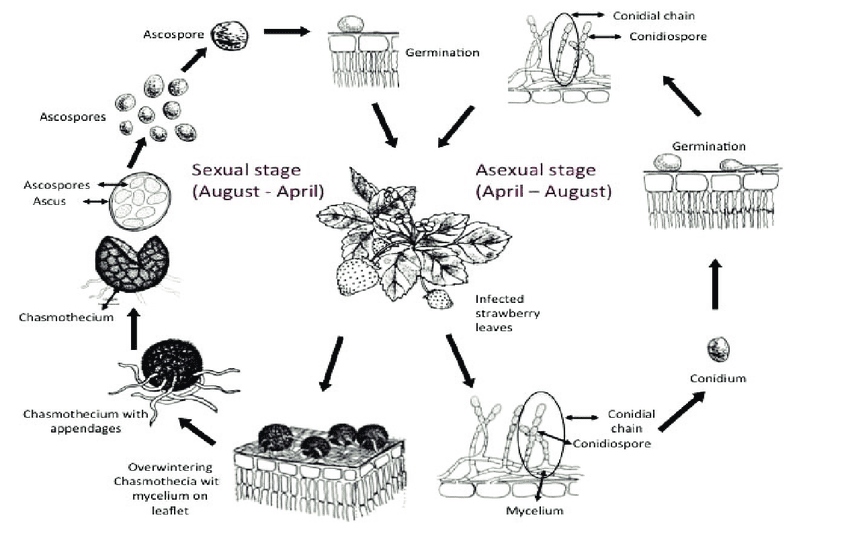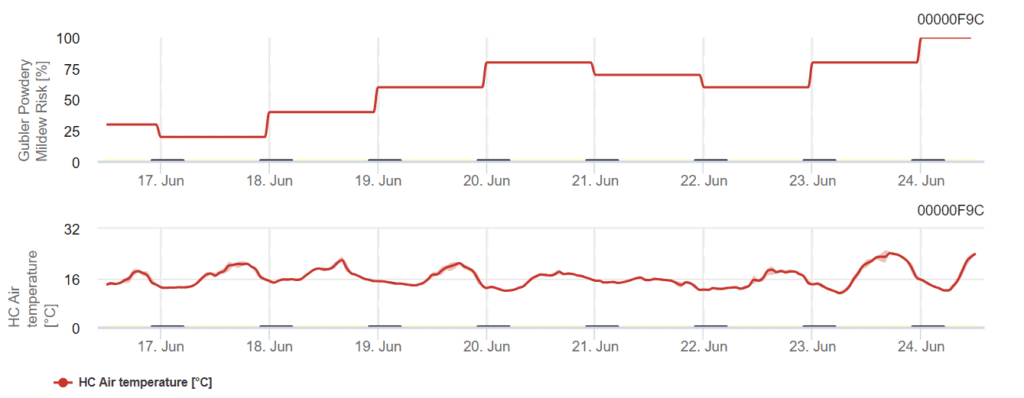
Çilekli hastalık modelleri
Antraknoz
Patojen
Çileklerde antraknoz, neden olduğu Colletotrichum acutatumsaplarda, sürgünlerde ve meyvelerde siyah, çökük lezyonlar şeklinde kendini gösterir. Bu mantar hastalığı, taç, kökler, yaprak sapları ve koşucular dahil olmak üzere bitkinin tüm kısımlarını etkiler.
Hastalık uygun koşullar altında hızla gelişebilir ve bir hafta veya daha kısa bir süre içinde meyvelerin 90%'sine kadar potansiyel olarak enfekte olabilir. Hem olgunlaşmamış hem de olgun meyveler enfeksiyona duyarlıdır, ancak hastalık en çok olgunlaşmakta olan veya tamamen olgunlaşmış meyvelerde yaygındır. Enfekte olmuş bitkiler veya bitki döküntüleri kışı geçiren inokulum kaynakları olarak hizmet edebilir. İlkbaharda, sporlar üretilir ve nispeten kısa mesafelerde yağmur ve rüzgarla dağılır.
Patojen bitkiye, kütikülaya nüfuz eden ve epidermal hücreleri istila eden bir appressorium yoluyla girer. Başlangıçta, C. acutatum biyotrofik bir fazda bulunur ve mantarın ölü hücreler içinde çoğaldığı nekrotrofik bir faza geçer. Hastalık ilerledikçe, mantar epidermal hücre duvarlarının altında akervulus yapıları oluşturur. Bu akervuluslar olgunlaşır ve özellikle yağmur sıçraması altında hastalığı daha hızlı yayan konidileri serbest bırakır. İkincil konidiler de önemli bir inokulum kaynağı olarak hizmet eder.
Semptomlar
Belirtiler ilk olarak en genç yaprakların solması şeklinde ortaya çıkar, bu yapraklar geçici olarak iyileşebilir ancak kısa süre sonra ölür. Yapraklarda, özellikle yaprakçıkların ucunda düzensiz siyah lekeler ortaya çıkar.
Taç dokusu daha sonra kırmızımsı bir renk alır ve bitki bozuldukça koyu kahverengiye veya siyaha döner. Enfekte taçlar genellikle kısmen hasar görür, bu da büyümenin durmasına yol açar ancak bitkinin tamamen ölmesine neden olmaz. Tipik olarak, tacın tamamı yerine sadece bir tarafı enfekte olur.
Yaprak sapları ve koşucu gövdeler üzerinde koyu renkli, uzun lezyonlar oluşur. Etkilenen yaprak sapları ve gövdeler lezyonlar tarafından kuşatılabilir ve yaprakların veya tüm yavru bitkilerin solmasına ve ölmesine neden olabilir.
Meyveler gelişimin herhangi bir aşamasında enfekte olabilir, sertleşir ve kahverengiye döner. Olgun meyvelerde çökük, koyu lezyonlar gelişir ve olgunlaşma yerine mumyalaşmaya yol açar. Meyveler ayrıca pembe veya somon renkli konidia kitleleriyle kaplı görünebilir.
FieldClimate Model
Genel Antraknoz Modeli
Sensörlere ihtiyaç var:
- Hava sıcaklığı
- Yaprak ıslaklığı
C. acutatum 15°C ila 30°C sıcaklık aralığında bitkileri enfekte eder, ancak uzun süreli bir yaprak ıslaklık periyoduna ihtiyaç vardır. Optimum 20°C ila 25°C sıcaklıklarda, 12 saatlik bir yaprak ıslaklık periyodu gereklidir. Enfeksiyon grafiği 100%'ye ulaştığında, enfeksiyon için tarlada en uygun koşullar sağlanmış olur.
Edebiyat
- Aljawasim, B. D., Samtani, J. B., & Rahman, M. (2023). Çileklerde antraknoz hastalıklarının tespiti ve yönetiminde yeni anlayışlar. Plants, 12(21), 3704.
- Ellis, M. A., & Erincik, O. (2008). Çilekte antraknoz. Ohio State University Extension.
- Smith, B. J. (2008). Çilek antraknozunun epidemiyolojisi ve patolojisi: Kuzey Amerika perspektifi. HortScience, 43(1), 69-73.
Toz halinde küf
Patojen

Çileklerde külleme hastalığına neden olan patojen Podosphaera aphanis. Miselyum ve cleistothecia olmak üzere iki şekilde kışı geçirir.
Kışı geçiren miselyum ilkbaharda aktif hale gelir ve olgunlaştığında konidyum (eşeysiz üreme sporları) salan konidiyoforlar üretir. Konidyumlar yeni bir dokuya yerleşir, çimlenir ve bitki hücrelerine nüfuz eden özel enfeksiyon yapıları olan appressoria oluşturur. Bu süreç yeni koloni oluşumuyla sonuçlanır.
Cleistothecia Mart'tan Mayıs'a kadar askosporlar (eşeyli üreme sporları) salar. Askosporlar da yeni dokulara iner, çimlenir ve yeni koloniler oluşturur.
Hem miselyum hem de konidiler birincil inokulum görevi görür. İkincil enfeksiyonlar çoğunlukla rüzgarla dağılan ve hızla yayılan konidiler yoluyla meydana gelir.
Çevresel koşullar daha az elverişli hale geldiğinde, mantar eşeyli üremeye - cleistothecia oluşumuna - geçer ve inokulumlar kışı geçirirken döngü tekrarlanır.
Semptomlar
Tüm toprak üstü kısımlarda beyaz toz halinde misel ve konidya lekeleri görülür ve birleşerek tüm yüzeyi kaplar. Genç organlar yaşlı olanlara göre daha hassastır. Yapraklar söz konusu olduğunda, üst taraf alt tarafa göre daha fazla külleme sergiler. Şiddetli enfeksiyon fotosentezin azalmasına, yaprak dökülmesine ve meyve deformasyonuna neden olur. Hastalık geliştikçe yaprak yukarı doğru kıvrılır ve yaprak yüzeylerinde mordan kırmızımsı lekeler oluşur.
FieldClimate Modelleri
Broome modifiye Gubler Modeli
Sensörlere ihtiyaç var:
- Hava sıcaklığı
Model, Broome tarafından tanıtılan yüksek sıcaklık eşiklerinde yapılan değişikliklerle Gubler çerçevesine dayanmaktadır. Riski hava sıcaklığı ile hesaplar ve risk endeksi 0 ila 100 arasında değişir. Endeksi tetiklemek için, 21°C ile 30°C arasında 6 saatten fazla sıcaklığa sahip üç ardışık gün gerekmektedir.
Endeks, bu koşulları karşılayan her gün için 20 puan artar (21°C ila 30°C'de en az 6 saat). Buna karşılık, bir gün bu sıcaklık aralığında 6 saatten az kalırsa veya sıcaklık 35°C'yi aşarsa, endeks 10 puan azalır.

Orijinal Gubler modeli 0,35 saat için 35°C'lik bir eşik belirlemiştir, ancak Broome birkaç ayrıntılı yüksek sıcaklık eşiği getirmiştir. Belirli sıcaklıklar (34°C, 36°C ve 38°C) yeterli süre boyunca karşılandığında, puanlar çıkarılır. Ayrıca, model mantar büyümesindeki gecikmeyi de hesaba katmaktadır; ertesi gün herhangi bir indeks kazanımı birkaç gün geciktirilir ve geciken her gün için beş ekstra puan düşülür.
30'un altındaki bir indeks 15 gün veya daha az bir üreme hızını gösterirken, 40~50 indeksi normal kabul edilir ve 8 ila 11 günlük bir üreme hızına işaret eder. İndeksin 60'ın üzerinde olması patojenin her 5 günde bir üremekte olduğunu gösterir ve spreyleme aralığının kısaltılması önerilir.
Çilek Toz Küf Modeli
Sensörlere ihtiyaç var:
- Hava sıcaklığı
- Bağıl nem
- Yaprak ıslaklığı
Bu model yaprak ıslaklığı ve bağıl nemi de başka bir modele dahil etmektedir. 21°C'nin üzerindeki hava sıcaklıkları ve 66%'nin üzerindeki bağıl nem riski artırırken, daha düşük sıcaklıklar, bağıl nem ve yaprak ıslaklığı riski azaltır.
60'ın altındaki risk endeksi düşük seviyede bitki koruma önlemlerini gösterirken, 60'ın üzerindeki risk hastalık riskinin arttığını ve ilaçlamanın tavsiye edileceğini gösterir. Daha uzun bir süre için 100'ün üzerindeki hastalık riskleri uygulama yoğunluğunun artırılmasını gerektirir.
Edebiyat
- Broome, J. C., Hand, E. K., Backup, P., Janousek, C. N., & Gubler, W. D. (2010, Haziran). Gubler-Thomas üzüm küllemesi risk endeksi için yüksek sıcaklık eşiğinin revize edilmesi. PHYTOPATHOLOGY içinde (Cilt 100, No. 6, s. S17-S18). 3340 PILOT KNOB ROAD, ST PAUL, MN 55121 ABD: AMERIKAN FITOPATOLOJI TOPLULUĞU.
- Gadoury, D. M., Asalf, B., Heidenreich, M. C., Herrero, M. L., Welser, M. J., Seem, R. C., ... & Stensvand, A. (2010). Podosphaera aphanis'in cleistothecia'sının başlaması, gelişmesi ve hayatta kalması ve bunların çilek küllemesi epidemiyolojisindeki rolü. Phytopathology, 100(3), 246-251.
- Jin XiaoLei, J. X., Fitt, B. D. L., Hall, A. M., & Huang YongJu, H. Y. (2013). Külleme (Podospheara aphanis) salgınlarının başlamasında chasmothecia'nın rolü ve çilekte salgınların kontrolünde silikonun rolü.
- Palmer, S. A. (2007). Çilek küllemesi: epidemiyoloji ve konukçu beslenmesinin hastalık üzerindeki etkisi (Doktora tezi).
- Aldrighetti, A., & Pertot, I. (2023). Çilek küllemesinin epidemiyolojisi ve kontrolü: bir derleme. Phytopathologia Mediterranea, 62(3), 427-453.
Önerilen ekipman
Bu ürünün potansiyel hastalıklarını izlemek için hangi sensör setinin gerekli olduğunu kontrol edin.
